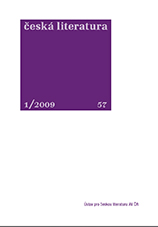Obraz (črta) v českém periodickém tisku první poloviny 19. století (příspěvek k poznání historické podoby žánru)
The Sketch in Czech Periodicals of the First Half of the Nineteenth Century: A Contribution on a Historical Form
Author(s): Lenka KusákováSubject(s): Literary Texts
Published by: AV ČR - Akademie věd České republiky - Ústav pro českou literaturu
Keywords: Czech Periodicals; Nineteenth Century; form; sketch
Summary/Abstract: In this article the author discusses the important role of the character sketch in the development of narrative prose in the mid-nineteenth century – its sources for content and form (the accent on description of milieu, the first-person narrator, the realia) helped to overcome the straight-jacketof the influence of the sentimental, novelistic storyline. The article, a result of the author’s long-term research on Czech Revivalist periodicals from 1786–1850, brings together material on the typology and development of the sketch. She notes the 1830s–40s boom in sketches and the prestige that the form enjoyed in the period – for instance, the participation of leading writers in its cultivation, its publication in serious periodicals and annuals, and its inclusion with high literature in Jungmann’s Slovesnost (Verbal art, 1845). Czech eriodicals of the 1830s and 1840s largely contained translations of works by foreign writers including Henry Bonaventure Monnier, Charles Dickens, Charles Paul de Kock, Jules Janin, and Faddei Venediktovich Bulgarin). Translation too, however, contributed to the development of the character sketch, which, on the one hand, adopted the fundamental attributes of the Western form (the moralizing, satirical tone, and attention to problems of big-city life and the special features of marginal peoples), and, on the other hand, pointed out special domestic features, in particular a nationalist and Slavophil propaganda function (for example, the thematization of the Bohemian or Slav countryside, the past and present of the Revival movement, the idealization of the rural Bohemian community as representative of the nation, and a critical, satirical view on national renegades or fashionable jingoism). The author has not, on the other hand, found any of the features that distinguish a Vienna type of Biedermeier ‘sketch’. The artistically most valuable, she believes, are original sketches like František Ladislav Čelakovský’s (1799–1852) ‘povahopisy’, Josef Kajetán Tyl’s (1808–1856) Prague and Kutná Hora physiological sketch’ influenced both by both Romantic views and by Revivalist ideology, the social-critical and critical patriotic sketch by Karel Havlíček (1821–1856), and the social-anthropological sketch that concentrates on the portrayal of the Bohemian and Slavonic folk by Karel Vladislav Zap (1812–1871) and his wife Honorata (1825–1856), as well as Božena Němcová (1820?–1862), Daniel Sloboda (1809–1888 ), Ludvík Rittersberk (1809–1858), and Bedřich Moser (1821–1864) in his satirical sketch of 1848. In addition to this topic, the author indicates numerous occurrences of a related form, the Lebensbild, which, like the sketch, endeavours to present a milieu, mostly socially problematic, but, more important, seeks to use the story line and the actants. Němcová’s Babička (The Grandmother, 1855) represents the height of the form.
Journal: Česká literatura
- Issue Year: 57/2009
- Issue No: 1
- Page Range: 1-25
- Page Count: 25
- Language: Czech

